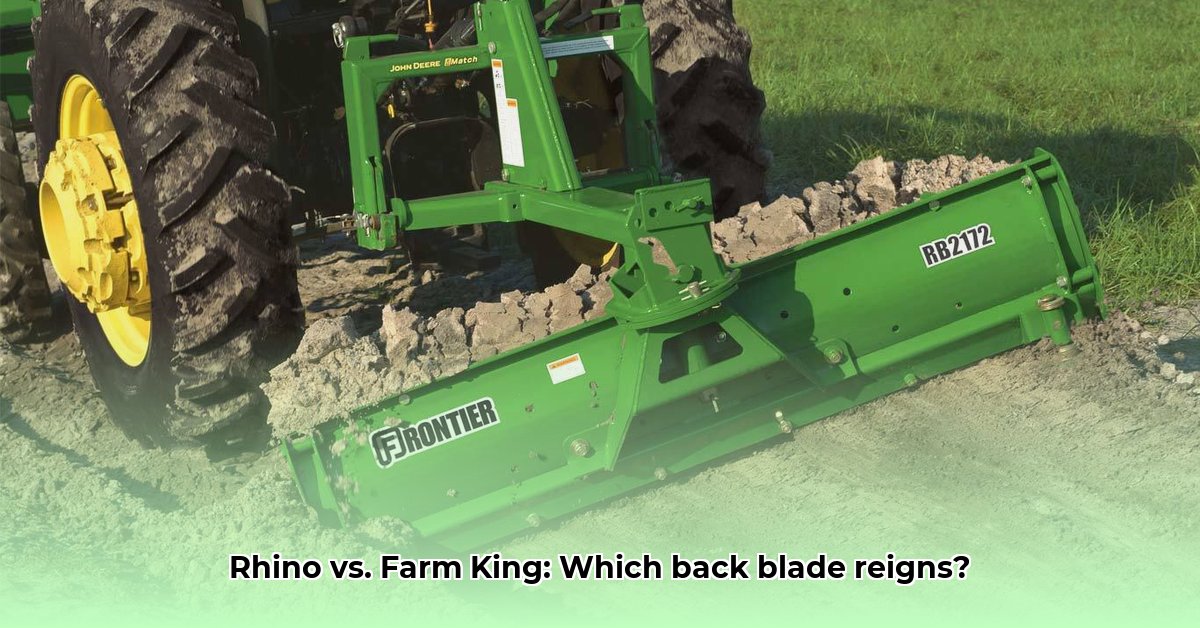
Choosing the right heavy-duty rear blade for your tractor significantly impacts efficiency and equipment longevity. This review compares Rhino and Farm King's Allied line of rear blades, analyzing key features, performance, maintenance, and use cases to help you make an informed decision. We'll explore hydraulic versus manual adjustments, examine blade designs, and consider user experiences to determine which blade best suits your needs and budget. For more rear blade options, check out this helpful resource.
Key Features Comparison: Rhino vs. Allied
Both Rhino and Allied rear blades utilize heavy-duty steel construction and replaceable cutting edges. However, key differences exist in adjustment mechanisms, design features, and price points. The table below summarizes these key distinctions. Note that specific dimensions and pricing vary widely depending on model and retailer. Always consult individual product specifications and local dealerships for the most up-to-date information.
| Feature | Rhino | Allied by Farm King |
|---|---|---|
| Adjustment | Primarily hydraulic; precise angle and tilt control. | Mix of hydraulic (larger models) and manual adjustments. |
| Cutting Edge Design | Extended design; reduced wear and tear. | Standard design |
| Optional Attachments | Wide array of options, including skid shoes and gauge wheels. | Options vary by model; check specifications. |
| Warranty | Varies by model and retailer; consult manufacturer's website. | Varies by model and retailer; consult manufacturer's website. |
| Price Range | Generally higher; varies by model and retailer. | Generally mid-range to higher end; varies by model and retailer. |
| Material Composition | High-strength steel; may use proprietary components. | High-strength steel; typically uses more readily available components. |
| Weight | Varies significantly by model; generally heavier for larger models. | Varies significantly by model; generally lighter for comparable sizes. |
Depth Analysis of Key Differences
Hydraulic vs. Manual Adjustments: A Control Comparison
Rhino blades predominantly utilize hydraulic adjustments, offering precise control over angle and tilt. This precision is particularly beneficial for intricate tasks and larger blades. Manual adjustments, often found in smaller Allied models, require more physical effort and offer less fine-tuned control. The choice hinges on your needs and budget; hydraulic systems typically command a higher initial cost but enhance efficiency and precision.
Moldboard Design and Performance Implications
Rhino’s extended moldboard design promotes smoother material flow and reduces wear and tear on the blade itself. This can translate to fuel savings and increased efficiency. Allied's standard moldboard design, while robust, may require more horsepower to achieve similar results. The optimal design depends on the intended use; for demanding tasks, the Rhino design's efficiency may outweigh its higher initial cost.
Performance Comparison: Real-World Considerations
Real-world performance depends on both blade design and maintenance. User reviews (sourced from 1) suggest that Rhino blades excel in heavy-duty applications like land clearing and snow removal due to their superior control and construction. Allied blades, while capable, are often favored for lighter tasks like landscaping due to their more competitive price point. However, always prioritize matching blade capacity to your tractor's capabilities.
Maintenance and Longevity: Long-Term Costs
Regular maintenance—including inspection of cutting edges, lubrication of moving parts, and prompt attention to hydraulic leaks—is crucial for extending the lifespan of either brand of blade. However, Rhino blades, with their potentially more complex hydraulic systems and possible use of proprietary parts, might incur greater repair expenses over time. Allied blades, using more readily available components in many models, could offer lower long-term maintenance costs. Choosing a blade requires weighing initial cost against potential future repair expenses.
Use Cases: Matching Blade to Task
Land clearing and heavy grading: Rhino blades, with their better control and typically heavier construction, are generally preferred. Their hydraulic systems offer greater precision in maneuvering and controlling material flow during intense operations.
Landscaping and lighter tasks: Allied blades, particularly the smaller, more affordable manual models, are well-suited for these applications.
Snow removal: The heavier construction and hydraulic control of Rhino blades often handle snow removal more efficiently.
Conclusion: Choosing the Right Blade
The “best” blade depends entirely on individual needs and budget. Rhino blades offer superior precision and performance for heavy-duty applications, but at a typically higher initial and potential long-term cost. Allied blades provide a more affordable option suitable for lighter applications. Always consider your tractor’s capabilities, the frequency and intensity of anticipated tasks, and your overall budget when making your selection. This review lacks firsthand testing; therefore, further research and consultation with local agricultural equipment suppliers are always recommended.
Risk Assessment Summary
Operating any agricultural equipment involves inherent risk. Mitigate these risks through regular maintenance, adherence to operating procedures, and adherence to safety guidelines. Always consult the manufacturer’s manual and prioritize safe operation.